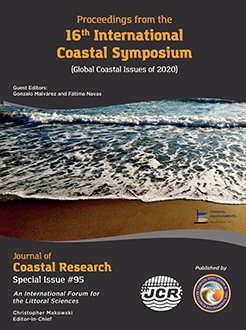Jullien, S.; Aucan, J.; Lefèvre, J.; Peltier, A., and Menkes, C.E., 2020. Tropical cyclone induced wave setup around New Caledonia during cyclone COOK (2017). In: Malvárez, G. and Navas, F. (eds.), Global Coastal Issues of 2020. Journal of Coastal Research, Special Issue No. 95, pp. 1454-1459. Coconut Creek (Florida), ISSN 0749-0208.
Tropical cyclone (TC)-induced coastal flooding arises from a combination of atmospheric surge, and energetic wave-induced setup. TC-generated waves in deep water considerably evolve in shallow water before reaching the coast. Islands surrounded by a barrier reef and lagoon are a particular case of steep and irregular bathymetry over which waves undergo various transformations, and induce complex wave-current interactions. The present study investigates the TC-induced coastal impact on the reef environment of New Caledonia in the tropical southwest Pacific. An unstructured wave-current model simulation encompassing New Caledonia and Vanuatu is used to describe the complete TC-induced waves impact, from wave generation to propagation and transformation in the coastal area. Comparison with in-situ measurements are performed during cyclone COOK in 2017. The results show that coastlines with a double protection (barrier and fringing reefs) are relatively sheltered from the waves induced by TCs (significant wave height is 3 m at the coast vs. 13 m offshore) while shores fronting the reef passes are more severely exposed with waves reaching 9 m close to the coast. Setups and currents that are associated to wave breaking on the barrier reef induce strong lagoon currents and localized sea level anomalies that does not necessarily reach the coast. In more sheltered bays, wave breaking at the entrance of the bay acts against outgoing currents. This phenomenon leads to an additional elevation of the mean water level in the bay.





